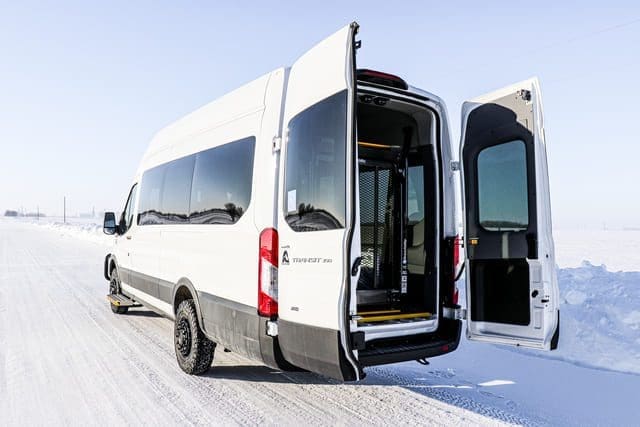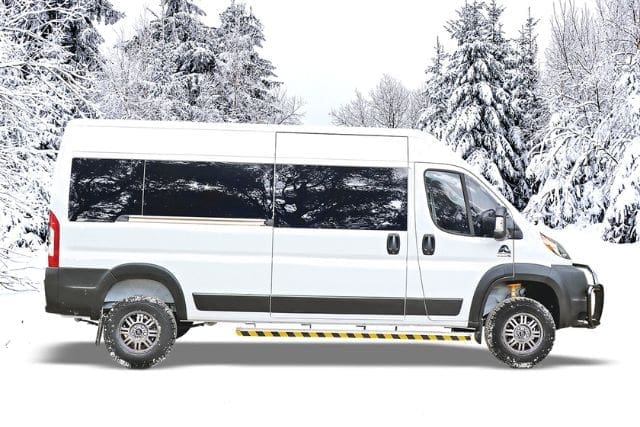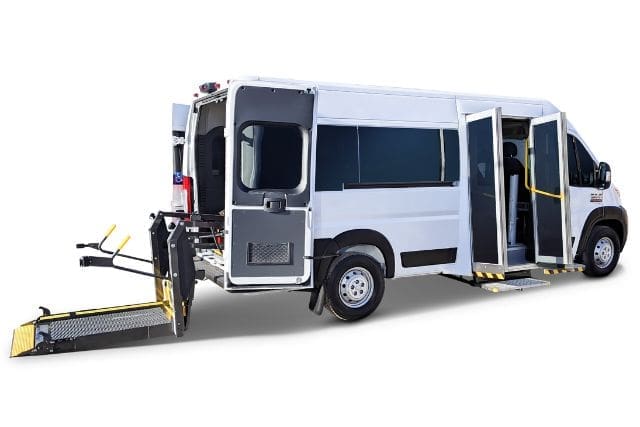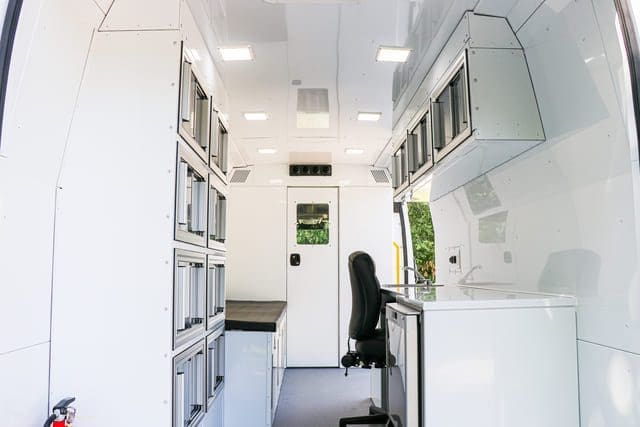You’ve finally found the perfect mobile medical or wheelchair accessible vehicle for your organization. Everything seems to be falling into place until you hit a roadblock and come across a term that leaves you scratching your head: Freight on board (FOB) shipping. What does freight on board mean? How does it impact your purchase?
Many organizations face a common challenge when dealing with FOB terms. You might face unexpected costs and risks if you don’t fully understand what FOB shipping entails. For instance, if you assume shipping costs are included but they’re not, your budget might take a hit. Or if you’re unclear about who’s responsible for damages during transit, you could end up covering extra expenses.
At MoveMobility, we’ve been providing innovative, mobile medical and wheelchair-accessible vehicles for over 10 years. We understand the challenges organizations face regarding transportation and logistics.
Our team at MoveMobility puts a lot of effort into ensuring your vehicle gets to you efficiently and safely. This is why understanding freight on board shipping is so important. Don’t worry, we’re here to guide you through it.
In this article, you’ll learn what freight on board shipping is, how it affects you as a buyer, and what details you need to know. After you’ve finished reading, you’ll clearly understand FOB shipping and how it applies to your vehicle purchase. Let’s dive in and demystify this shipping term together.
What is freight on board shipping?
Freight on board shipping can seem confusing at first, but it’s helpful to understand it when purchasing a vehicle in Canada. Let’s break it down.
The freight on board definition is a shipping term that shows when the responsibility, costs, and risks of shipping transfer from the seller (MoveMobility) to the buyer (you). In simple terms, it tells you when you start covering the costs and risks in the shipping process.
For example, suppose you’re a First Nation community that has just purchased a mobile medical van. In that case, MoveMobility is responsible for all transportation costs and risks up to the agreed-upon delivery address. If this is an accessible reserve via all-season roads, we would bring it there.
Costs and risks: Up until the FOB point, MoveMobility covers all transportation costs, including insurance and any risk of damage. Once the vehicle reaches the specified FOB location, these responsibilities transfer to you. We’ll talk more about costs later in the article.
FOB points: The FOB points can vary. It could be the final destination, like your organization or First Nation community, or an intermediate stop, like the Port of Montreal.
Why Is understanding freight on board important?
Understanding freight on board is so important for a couple of reasons.
Financial planning: Knowing who is responsible for which costs helps you plan your budget more accurately. You won’t be caught off guard by unexpected shipping expenses.
Risk management: Understanding when the risk transfers to you allows you to make informed decisions about additional insurance or precautionary measures.
Clear communication: Being clear about FOB terms ensures that there are no misunderstandings between you and MoveMobility. This clarity helps build trust and a smoother transaction process.
What are some examples of freight on board shipping?
Let’s look at a few practical scenarios to understand how FOB shipping works:
FOB Port of Montreal
In this scenario, MoveMobility will cover the costs and risks of transporting the vehicle up to the Port of Montreal. This means we ensure the vehicle reaches the port safely and handle all costs involved up to that point. After the vehicle arrives at the port, you take on the responsibility and costs for the next leg of the journey, such as sealift costs to transport the vehicle further.
There are specific situations where the FOB point can be important in understanding who bears the cost and risk:
Ice roads

For communities only accessible via ice roads, MoveMobility typically delivers the vehicle to the final all-season road destination. On the quote, this might be labeled as “FOB Cochrane head of ice road” or a similar term. From there, the buyer is responsible for transportation over the ice roads, bearing all costs and risks beyond the designated FOB point.
Railheads
If a vehicle is to be transported part of the way by train, the FOB point might be the railhead or yard where the vehicle boards the train. For instance, if we say “FOB Toronto Rail Yard,” MoveMobility covers all costs and risks up to that rail yard, and from there, you take over.
Sealift
For deliveries requiring sealift, MoveMobility often delivers the vehicle to a port like Montreal, Quebec City, or another location along the St. Lawrence River. If your quote says “FOB Port of Montreal,” we handle everything up to the port.
For small coastal communities in Newfoundland and Labrador, the FOB point might be the ferry yard or compound in Goose Bay, where we ensure the vehicle gets to before it boards a ferry.
Understand the costs involved in freight on board shipping
Knowing what costs are included in your quote is another important thing to keep in mind with freight on board shipping. This helps you avoid surprises and plan your budget better. Here’s a simple breakdown.
The quote you get for delivery includes all the costs needed to get the vehicle to the specified FOB point. MoveMobility handles these expenses until the vehicle reaches that point. These costs include:
- Transportation fees: The cost of moving the vehicle from our facility to the FOB point.
- Insurance: Coverage for any possible damage during transit up to the FOB point.
- Handling and logistics: Fees for loading, unloading, and managing the transport process. For example, if your vehicle’s FOB point is Ginoogaming First Nation, your quote will cover all costs to deliver the vehicle to an address on the reserve.
Are there any extra costs with freight on board shipping?
Sometimes, extra transportation is needed to get your vehicle to you. This might require a sealift or an ice road flatbed truck. These extra services mean higher costs because of the extra work and risks involved. Here’s why:
Sealift costs: If the vehicle needs to be transported by sealift beyond a port like Montreal or Quebec City, these extra costs will be added to the quote. This involves special handling fees and longer transit times.
Ice road transportation: For communities accessible via ice roads, we must hire a flatbed truck for ice roads if delivery needs to go beyond the final all-season road destination. This is a special service with higher costs due to the risks and challenges involved.
Let’s take a quick look at an example to help you understand all of this better.
Imagine your organization is in a remote area requiring a sealift for final delivery. Here’s an overview of how it works:
1. Quote preparation: MoveMobility prepares a quote that includes all costs up to the Port of Montreal, the initial FOB point.
2. Sealift request: Your community also asks MoveMobility to cover the sealift costs.
3. Cost adjustment: MoveMobility adjusts the quote to include the sealift transportation costs, detailing the extra fees and risks involved.
4. Final delivery: Once agreed, MoveMobility handles all logistics up to the final destination, ensuring the vehicle reaches you safely.
Understanding freight on board shipping and your next steps

You came to this article wanting to understand freight on board shipping, especially how it affects your purchase of a mobile medical or wheelchair accessible vehicle. After reading, you now know what FOB shipping is, why it’s important, and how it impacts you as a buyer.
At MoveMobility, we’ve been helping organizations like yours for over a decade. Our expertise in FOB shipping ensures that your vehicle arrives safely and without unexpected costs. We take pride in our clear communication and dedication to making the delivery process smooth and stress-free.
If you have any questions about freight on board shipping or need further assistance, click the button below to talk to a mobility expert. We’re here to help you every step of the way.
If you’re not quite ready to talk to someone yet, you should check out these other two cost articles that highlight what you can expect to pay for a mobile medical or wheelchair accessible van.
You also might be interested in our mobile medical and wheelchair accessible van buyer’s guides. These guides have a tremendous amount of information that will help you make the right purchasing decision. To access these guides, scroll down a bit, and you’ll see a section where you can click on each one.
FAQ
Q: What if there’s an accident before the FOB point?
A: If an accident occurs before the vehicle reaches the FOB point, MoveMobility is responsible for handling the situation, including any insurance claims or repairs needed.
Q: What happens if the vehicle is damaged after the FOB point?
A: The responsibility lies with you if the vehicle is damaged after the FOB point. Ensure you have insurance to cover any potential damages and coordinate with your logistics provider to handle the situation effectively.
Q: What should I do once the vehicle reaches the FOB point?
A: Once the vehicle reaches the FOB point, you should be prepared to take over responsibility. This includes arranging for further transportation if needed and ensuring you have the necessary insurance coverage.
Q: Are there any hidden fees I should be aware of?
A: At MoveMobility, we strive for transparency. The quote you receive includes all costs up to the FOB point. If additional services are required, such as sealift or ice road transportation, we will inform you of the extra costs upfront.






